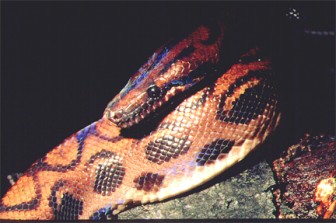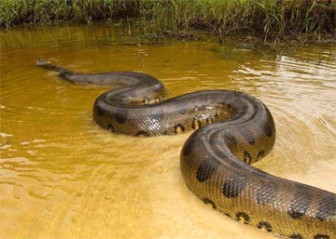In Guyana there are eight snake families. The main families are the pit vipers, the elapides (coral snakes), the colubrids (largely non-venomous snakes) and the boids. The Boidae family of snakes are found through Central and South America and the Caribbean. They are ovoviviparous meaning they give birth to live young. Gestation is between 7 to 10 months. There are only five species of boas found in Guyana: the Anaconda or ‘Water Camoudi’ (Eunectes murinus, Boa Constrictor or ‘Land Camoudi’ (Boa constrictor), Emerald Tree Boa (Corallus caninus), Rainbow Boa (Epicrates cenchria), and Amazon Tree Boa (Corallus hortulanus). The Anaconda is considered the largest of the boas as it grows to be the heaviest.

Boas are snakes that wind themselves around their prey and kill by constriction. As the prey exhales the snake tighten the coils wrapped around the prey; breaking their bones and collapsing their organs before killing them in the squeezing process. Of the five species the Emerald Tree Boa and Amazon Tree Boa are arboreal, spending their time in the trees. They are nocturnal and can be found coiled on a branch during the day. At nights they can be found with their heads hanging downwards waiting to snag their prey. The other three species are terrestrial but will spend large amounts of time near the water when hunting.
All five species of boa are found in the pet trade but the most coveted is the Rainbow Boa and the various colour morphs of the Amazon Tree Boa as they have dazzling colours and skin patterns. While the Boa Constrictor can have varying base colours with the well known red saddle design, the Amazon Tree Boa can be found in about seven various colours or a combination of these.

The neonate of the Emerald Tree Boa is born a bright orange to brick red colour which changes into emerald green as the snake reaches maturity. This species can be found in many habitats especially associated with water and are commonly found in trees as their name suggests. These snakes hunt mostly at night and feed on prey ranging from small birds, mammals and frogs to large sized mammals.
Within the Makushi culture some species have medicinal uses. The boa constrictor is believed to bring good luck and can provide protection from other snake species, while the Emerald Tree Boa is known as a token snake. If the snake is seen below the waist this means your life span will be short but if seen above it you will have a long life.
Rain forests are rich in biodiversity and are home to many different plants and animals. In addition, indigenous communities make their homes there. Even if you don’t live in the rain forest, humans rely on the forest for resources such as building materials (wood and lianas), medicine and fruits. Rain forests also provide essential environmental services for life on earth; they create soil as well as prevent soil erosion, produce oxygen though photosynthesis, maintain clean water systems, and are a key defence against climate change.
The Iwokrama Rain Forest is 371,000 hectares, located in the heart of Guyana. Our mission is to develop strategies for conservation and sustainable development for local people in Guyana and the world at large. We are involved in tourism, training, research and our timber is certified by the Forest Stewardship Council. Come and visit us in the rain forest or at http://www.iwokrama.org.




